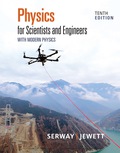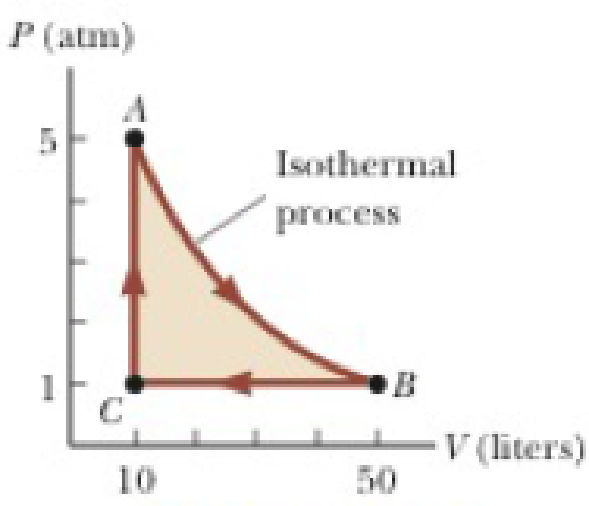
A 1.00-mol sample of an ideal monatomic gas is taken through the cycle shown in Figure P21.37. The process A → B is a reversible isothermal expansion. Calculate (a) the net work done by the gas, (b) the energy added to the gas by heat, (c) the energy exhausted from the gas by heat, and (d) the efficiency of the cycle. (e) Explain how the efficiency compares with that of a Carnot engine operating between the same temperature extremes.
Figure P21.37

(a)
The net work done by the gas.
Answer to Problem 37AP
The net work done by the gas is
Explanation of Solution
Given Info: The pressure and volume at A are
The formula for the net work done by the gas at
Here,
Substitute
Thus, the net work done by the gas at
The formula for the net work done by the gas at
Here,
Substitute
Thus, the net work done by the gas at BC is
The formula for the net work done by the gas at
As the change in the volume between processes
Thus, the net work done by the gas at
The formula for the total work done by the gas is,
Substitute
Conclusion:
Therefore, the total work done is
(b)
The energy added to the gas by heat.
Answer to Problem 37AP
The energy added to the gas by heat is
Explanation of Solution
Given Info: The pressure and volume at
The formula for the energy added by the gas in process
Substitute
Thus, the energy added by the gas in process
The formula for temperature at
Substitute
Thus, the temperature at
The formula for temperature at
Substitute
Thus, the temperature at
The formula for the energy added by the gas in process
Here,
Substitute
Thus, the energy added in process
The formula for the total energy added is,
Substitute
Thus, the total energy added is
Conclusion:
Therefore, the total energy added is
(c)
The energy exhausted from the gas by heat.
Answer to Problem 37AP
The energy exhausted from the gas by heat is
Explanation of Solution
Given Info: The pressure and volume at A are
The formula for the energy added by the gas in process
Substitute
Thus, the energy exhausted in process
Conclusion:
Therefore, the energy exhausted in process
(d)
The efficiency of the cycle.
Answer to Problem 37AP
The efficiency of the cycle is
Explanation of Solution
Given Info: The pressure and volume at A are
Formula to calculate the efficiency of the engine is,
Here,
Substitute
Thus, the efficiency of the engine is
Conclusion:
Therefore, the efficiency of the engine is
(e)
The comparison of efficiency to that of the Carnot engine.
Answer to Problem 37AP
The efficiency of Carnot engine is
Explanation of Solution
Given Info: The pressure and volume at A are
Formula to calculate the efficiency of the Carnot engine is,
Substitute
Conclusion:
Therefore, the efficiency of Carnot engine is
Want to see more full solutions like this?
Chapter 21 Solutions
Physics for Scientists and Engineers with Modern Physics
Additional Science Textbook Solutions
Organic Chemistry (8th Edition)
Principles of Anatomy and Physiology
Biochemistry: Concepts and Connections (2nd Edition)
Laboratory Manual For Human Anatomy & Physiology
Brock Biology of Microorganisms (15th Edition)
Introductory Chemistry (6th Edition)
- Please don't use Chatgpt will upvote and give handwritten solutionarrow_forwardNo chatgpt pls will upvotearrow_forwardThe shear leg derrick is used to haul the 200-kg net of fish onto the dock as shown in. Assume the force in each leg acts along its axis. 5.6 m. 4 m- B Part A Determine the compressive force along leg AB. Express your answer to three significant figures and include the appropriate units. FAB = Value Submit Request Answer Part B Units ? Determine the compressive force along leg CB. Express your answer to three significant figures and include the appropriate units. FCB= Value Submit Request Answer Part C ? Units Determine the tension in the winch cable DB. Express your answer with the appropriate units. 2marrow_forward
- Part A (Figure 1) shows a bucket suspended from a cable by means of a small pulley at C. If the bucket and its contents have a mass of 10 kg, determine the location of the pulley for equilibrium. The cable is 6 m long. Express your answer to three significant figures and include the appropriate units. Figure 4 m B НА x = Value Submit Request Answer Provide Feedback < 1 of 1 T 1 m Units ?arrow_forwardThe particle in is in equilibrium and F4 = 165 lb. Part A Determine the magnitude of F1. Express your answer in pounds to three significant figures. ΑΣΦ tvec F₁ = Submit Request Answer Part B Determine the magnitude of F2. Express your answer in pounds to three significant figures. ΑΣΦ It vec F2 = Submit Request Answer Part C Determine the magnitude of F3. Express your answer in pounds to three significant figures. ? ? lb lb F₂ 225 lb 135° 45° 30° -60°-arrow_forwardThe 10-lb weight is supported by the cord AC and roller and by the spring that has a stiffness of k = 10 lb/in. and an unstretched length of 12 in. as shown in. Part A Determine the distance d to maintain equilibrium. Express your answer in inches to three significant figures. 節 ΕΠΙ ΑΣΦ d = *k J vec 5 t 0 ? d C A in. 12 in. Barrow_forward
- The members of a truss are connected to the gusset plate as shown in . The forces are concurrent at point O. Take = 90° and T₁ = 7.5 kN. Part A Determine the magnitude of F for equilibrium. Express your answer to three significant figures and include the appropriate units. F = Value Submit Request Answer Part B 0 ? Units Determine the magnitude of T2 for equilibrium. Express your answer to three significant figures and include the appropriate units. ? T₂ = Value Units T₁ Carrow_forwardpls help on botharrow_forwardpls helparrow_forward
- pls helparrow_forward6. 6. There are 1000 turns on the primary side of a transformer and 200 turns on thesecondary side. If 440 V are supplied to the primary winding, what is the voltageinduced in the secondary winding? Is this a step-up or step-down transformer? 7. 80 V are supplied to the primary winding of a transformer that has 50 turns. If thesecondary side has 50,000 turns, what is the voltage induced on the secondary side?Is this a step-up or step-down transformer? 8. There are 50 turns on the primary side of a transformer and 500 turns on thesecondary side. The current through the primary winding is 6 A. What is the turnsratio of this transformer? What is the current, in milliamps, through the secondarywinding?9. The current through the primary winding on a transformer is 5 A. There are 1000turns on the primary winding and 20 turns on the secondary winding. What is theturns ratio of this transformer? What is the current, in amps, through the secondarywinding?arrow_forwardNo chatgpt plsarrow_forward
 Physics for Scientists and Engineers with Modern ...PhysicsISBN:9781337553292Author:Raymond A. Serway, John W. JewettPublisher:Cengage Learning
Physics for Scientists and Engineers with Modern ...PhysicsISBN:9781337553292Author:Raymond A. Serway, John W. JewettPublisher:Cengage Learning Principles of Physics: A Calculus-Based TextPhysicsISBN:9781133104261Author:Raymond A. Serway, John W. JewettPublisher:Cengage Learning
Principles of Physics: A Calculus-Based TextPhysicsISBN:9781133104261Author:Raymond A. Serway, John W. JewettPublisher:Cengage Learning Physics for Scientists and Engineers, Technology ...PhysicsISBN:9781305116399Author:Raymond A. Serway, John W. JewettPublisher:Cengage Learning
Physics for Scientists and Engineers, Technology ...PhysicsISBN:9781305116399Author:Raymond A. Serway, John W. JewettPublisher:Cengage Learning Physics for Scientists and Engineers: Foundations...PhysicsISBN:9781133939146Author:Katz, Debora M.Publisher:Cengage Learning
Physics for Scientists and Engineers: Foundations...PhysicsISBN:9781133939146Author:Katz, Debora M.Publisher:Cengage Learning Physics for Scientists and EngineersPhysicsISBN:9781337553278Author:Raymond A. Serway, John W. JewettPublisher:Cengage Learning
Physics for Scientists and EngineersPhysicsISBN:9781337553278Author:Raymond A. Serway, John W. JewettPublisher:Cengage Learning





